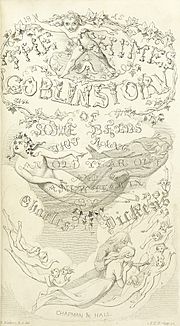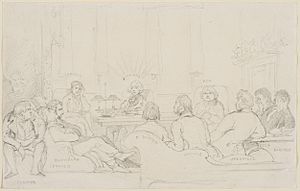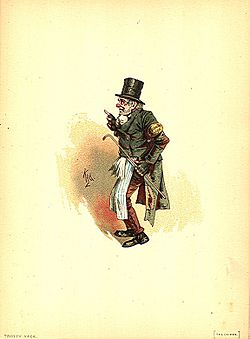The Chimes facts for kids

Title page of first edition, 1844 with engraving by F.P. Becker
|
|
| Author | Charles Dickens |
|---|---|
| Original title | The Chimes: A Goblin Story of Some Bells that Rang an Old Year Out and a New Year In |
| Illustrator | Daniel Maclise Richard Doyle John Leech William Clarkson Stanfield |
| Country | England |
| Language | English |
| Genre | Novella |
| Publisher | Chapman & Hall |
|
Publication date
|
1844 |
| Media type | Print (hardback & paperback) |
| Pages | 175 pp |
| Preceded by | A Christmas Carol |
| Followed by | The Cricket on the Hearth |
The Chimes: A Goblin Story of Some Bells that Rang an Old Year Out and a New Year In, commonly referred to as The Chimes, is a novella written by Charles Dickens and first published in 1844, one year after A Christmas Carol. It is the second in his series of "Christmas books," five novellas with strong social and moral messages that he published during the 1840s. In addition to A Christmas Carol and The Chimes, the Christmas books include The Cricket on the Hearth (1845), The Battle of Life (1846), and The Haunted Man and the Ghost's Bargain (1848).
Contents
Development history
The book was written in late 1844, during Dickens's year-long visit to Italy. John Forster, his first biographer, records that Dickens, hunting for a title and structure for his next contracted Christmas story, was struck one day by the clamour of the Genoese bells audible from the villa where they were staying.
All Genoa lay beneath him, and up from it, with some sudden set of the wind, came in one fell sound the clang and clash of all its steeples, pouring into his ears, again and again, in a tuneless, grating, discordant, jerking, hideous vibration that made his ideas "spin round and round till they lost themselves in a whirl of vexation and giddiness, and dropped down dead."
Two days later Forster received a letter from Dickens which read simply: ""We have heard THE CHIMES at midnight, Master Shallow!", and the writing of the book began. Forster describes Dickens's intentions in writing The Chimes as striking "a blow for the poor".
When he came [...] to think of his new story for Christmas time, he resolved to make it a plea for the poor ... He was to try and convert Society, as he had converted Scrooge, by showing that its happiness rested on the same foundations as those of the individual, which are mercy and charity not less than justice.
Dickens returned to London for a week in December 1844 and gave readings of the finished book to friends prior to publication, to judge its impact. The artist Daniel Maclise, who had contributed two illustrations to The Chimes and attended two of these events, portrayed the reading of 3 December 1844 in a well-known sketch.
Explanation of the novel's title
The chimes are old bells in the church on whose steps Trotty Veck plies his trade. The book is divided into four parts named "quarters", after the quarter chimes of a striking clock. (This parallels Dickens naming the parts of A Christmas Carol "staves" – that is "stanzas" – and dividing The Cricket on the Hearth into "chirps".)
Plot summary
On New Year's Eve, Trotty, a poor elderly "ticket-porter" or casual messenger, is filled with gloom at the reports of crime and immorality in the newspapers, and wonders whether the working classes are simply wicked by nature. His daughter Meg and her long-time fiancé Richard arrive and announce their decision to marry next day. Trotty hides his misgivings, but their happiness is dispelled by an encounter with the pompous Alderman Cute, plus a political economist and a young gentleman with a nostalgia, all of whom make Trotty, Meg and Richard feel they hardly have a right to exist, let alone marry.
Trotty carries a note for Cute to Sir Joseph Bowley MP, who dispenses charity to the poor in the manner of a paternal dictator. Bowley is ostentatiously settling his debts to ensure a clean start to the new year, and berates Trotty because he owes a little rent and ten or twelve shillings to his local shop which he cannot pay off. Returning home, convinced that he and his fellow poor are naturally ungrateful and have no place in society, Trotty encounters Will Fern, a poor countryman, and his orphaned niece, Lilian. Fern has been accused of vagrancy and wants to visit Cute to set matters straight, but from a conversation overheard at Bowley's house, Trotty is able to warn him that Cute plans to have him arrested and imprisoned. He takes the pair home with him and he and Meg share their meagre food and poor lodging with the visitors. Meg tries to hide her distress, but it seems she has been dissuaded from marrying Richard by her encounter with Cute and the others.
In the night, the bells seem to call Trotty. Going to the church, he finds the tower door unlocked and climbs to the bellchamber, where he discovers the spirits of the bells and their goblin attendants who reprimand him for losing faith in man's destiny to improve. He is told that he fell from the tower during his climb and is now dead, and Meg's subsequent life must now be an object lesson for him. There follows a series of visions which he is forced to watch, helpless to interfere with the troubled lives of Meg, Richard, Will and Lilian over the subsequent years.
The chimes' intention is to teach Trotty that, far from being naturally wicked, mankind is formed to strive for nobler things, and will fall only when crushed and repressed beyond bearing.
At the end of the book, Trotty finds himself awakening at home as if from a dream as the bells ring in the New Year of the day Trotty originally climbed the tower. Meg and Richard have chosen to wed, and all of her friends have spontaneously chosen to provide a wedding feast and celebration. The author explicitly invites the reader to decide if this "awakening" is a dream-within-a-dream. The reader must choose between the harsh consequences of the behaviour of the upper classes in Trotty's vision, or the happiness of the wedding.
Main characters
- Toby "Trotty" Veck, the protagonist, a poor elderly messenger or "ticket-porter."
- Margaret "Meg" Veck, Toby's 21-year-old daughter
- Mrs. Anne Chickenstalker, the local shopkeeper
- Alderman Cute, a Justice of the Peace
- Mr. Filer, a political economist in the Utilitarian mould
- Sir Joseph Bowley, a rich paternalist MP
- Will Fern, a countryman
- Lilian Fern, Will's orphaned niece
Major themes
This is a campaigning story like its predecessor A Christmas Carol, written with the intention of swaying readers towards Dickens's moral message. The chimes represent time, and the main themes of the story are summarised in the three wrongs they accuse Trotty of committing:
- Harking back to a golden age that never was, instead of striving to improve conditions here and now.
- Believing that individual human joys and sorrows do not matter to a higher power.
- Condemning those who are fallen and unfortunate, and offering them neither help nor pity.
'Who turns his back upon the fallen and disfigured of his kind; abandons them as vile; and does not trace and track with pitying eyes the unfenced precipice by which they fell from good—grasping in their fall some tufts and shreds of that lost soil, and clinging to them still when bruised and dying in the gulf below; does wrong to Heaven and man, to time and to eternity. And you have done that wrong!'
Adaptations
In 1914, the book was made into a silent film, The Chimes, directed by Thomas Bentley.
A musical adaptation of The Chimes was created in 1992 by Lisa Kofod and Gay Donat Reed, with music by Paul Johnson. A staged reading of this work was produced at The Workhouse Theatre in New York City.
The Chimes was adapted into a 24-minute clay-animated film in 2000 by Xyzoo Animation. It won a Cine Special Jury award in 2002.
The Colonial Radio Theatre in Boston produced a full cast radio production of The Chimes in 2000. This was released on CD by Blackstone Audio in 2007, and re-released by Brilliance Audio in 2011.
In 2004, a stage adaptation by Les Smith premiered at the Southwark Playhouse.
In 2015, Audible issued The Chimes as a free audible book with Christmas well wishes from the company to its subscribers.
See also
 In Spanish: Las campanas (novela de Charles Dickens) para niños
In Spanish: Las campanas (novela de Charles Dickens) para niños



